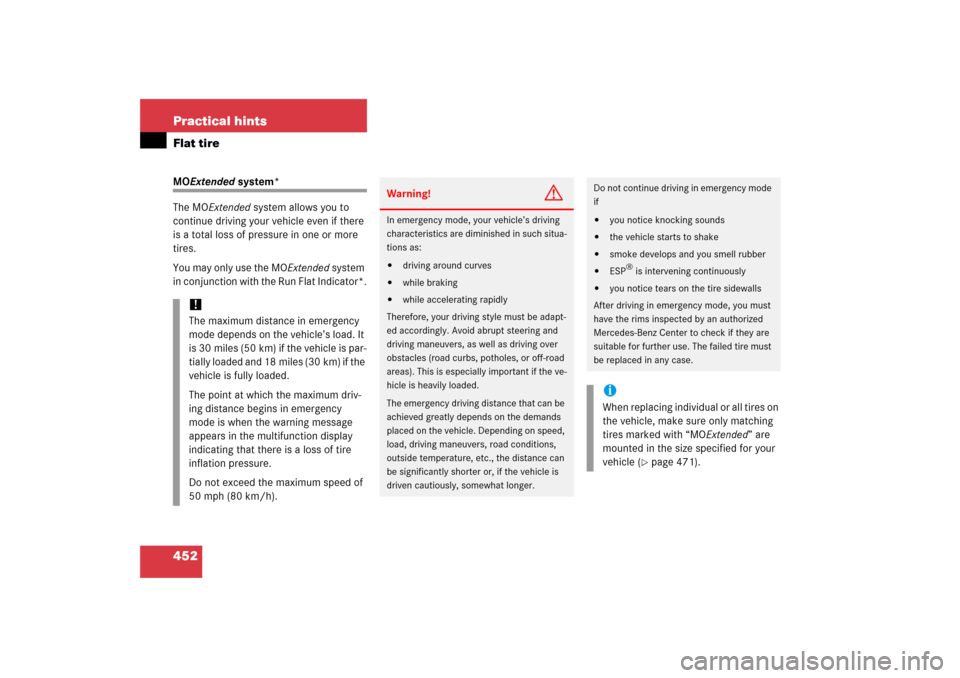Page 452 of 514
451 Practical hints
Flat tire
Lowering the vehicle�
Lower vehicle by turning crank coun-
terclockwise until the full weight of the
vehicle is resting on the ground.
�
Remove the jack.
1 - 5 Wheel bolts
�
Tighten the five wheel bolts evenly,
following the diagonal sequence
illustrated (1 to 5), until all bolts are
tight. Observe a tightening torque
of 80 lb-ft (110 Nm).Before storing the jack, it should be fully
collapsed, with handle folded in (storage
position) (
�page 415).
�
Store the jack and the other vehicle
tools in the trunk.Warning!
G
Have the tightening torque checked after
changing a wheel. The wheels could come
loose if they are not tightened to a torque of
80 lb-ft (110 Nm).
Page 453 of 514

452 Practical hintsFlat tireMOExtended system*
The MOExtended system allows you to
continue driving your vehicle even if there
is a total loss of pressure in one or more
tires.
You may only use the MOExtended system
in conjunction with the Run Flat Indicator*.
!The maximum distance in emergency
mode depends on the vehicle’s load. It
is 30 miles (50 km) if the vehicle is par-
tially loaded and 18 miles (30 km) if the
vehicle is fully loaded.
The point at which the maximum driv-
ing distance begins in emergency
mode is when the warning message
appears in the multifunction display
indicating that there is a loss of tire
inflation pressure.
Do not exceed the maximum speed of
50 mph (80 km/h).
Warning!
G
In emergency mode, your vehicle’s driving
characteristics are diminished in such situa-
tions as:�
driving around curves
�
while braking
�
while accelerating rapidly
Therefore, your driving style must be adapt-
ed accordingly. Avoid abrupt steering and
driving maneuvers, as well as driving over
obstacles (road curbs, potholes, or off-road
areas). This is especially important if the ve-
hicle is heavily loaded.
The emergency driving distance that can be
achieved greatly depends on the demands
placed on the vehicle. Depending on speed,
load, driving maneuvers, road conditions,
outside temperature, etc., the distance can
be significantly shorter or, if the vehicle is
driven cautiously, somewhat longer.
Do not continue driving in emergency mode
if�
you notice knocking sounds
�
the vehicle starts to shake
�
smoke develops and you smell rubber
�
ESP
® is intervening continuously
�
you notice tears on the tire sidewalls
After driving in emergency mode, you must
have the rims inspected by an authorized
Mercedes-Benz Center to check if they are
suitable for further use. The failed tire must
be replaced in any case.iWhen replacing individual or all tires on
the vehicle, make sure only matching
tires marked with “MOExtended” are
mounted in the size specified for your
vehicle (
�page 471).
Page 462 of 514

461 Practical hints
Towing the vehicle
Towing eye bolt CLK 500/CLK 55 AMG
Towing eye bolt in front bumper
The cover for the threaded bore in the front
bumper is identical to the cover on the
CLK 350.
To remove and to reinstall cover, see “Tow-
ing eye bolt CLK 350” (
�page 460).
Towing eye bolt in rear bumper
1Cover on right side of rear bumper
2Recess in the coverTo remove cover 1:
�
Insert flat, blunt object as a lever in
recess 2 on the edge of cover 1.
�
Loosen cover 1 from the bumper us-
ing lever, to reveal the threaded hole
for towing eye bolt.
The towing eye bolt is supplied with the
tool kit (located in the compartment
underneath the trunk floor).
�
Screw towing eye bolt in to its stop and
tighten with lug wrench.To reinstall cover 1:
�
Hook right-hand side of the cover1
into opening.
�
Slide cover1 as far as it will go in the
direction of the arrow3.
�
Gently press left-hand side of cover1
in direction of the arrow4.
The hooks on the left-hand side
engage.iWhen closing the cover1, make sure
the cover’s check strap does not get
caught.
Page 472 of 514

471 Technical data
Rims and tires
�Rims and tires
!
Only use tires which have been tested
and approved by Mercedes-Benz. Tires
approved by Mercedes-Benz are devel-
oped to provide best possible perfor-
mance in conjunction with the driving
safety systems on your vehicle such as
ABS or ESP
®. Tires specially developed
for your vehicle and tested and ap-
proved by Mercedes-Benz can be iden-
tified by finding the following on the
tire’s sidewall:
�
MO = M
ercedes-Benz O
riginal
equipment tires
AMG vehicles:
Does not apply to all approved tires
on AMG vehicles. For information
on tested and approved tires for
AMG vehicles, contact an autho-
rized Mercedes-Benz Center.
�
MOE = M
ercedes-Benz O
riginal
E
xtended (tires with limited run-flat
characteristics) original equipment
tires
Using tires other than those approved
by Mercedes-Benz may result in dam-
age that is not covered by the
Mercedes-Benz Limited Warranty.iFor information on driving with
MOExtended tires, see
“MOExtendedsystem*” (
�page 345).
!Using tires other than those approved
by Mercedes-Benz can have detrimen-
tal effects, such as�
poor handling characteristics
�
increased noise
�
increased fuel consumption
Moreover, tires and rims not approved
by Mercedes-Benz may, under load,
exhibit dimensional variations and dif-
ferent tire deformation characteristics
that could cause them to come into
contact with the vehicle body or axle
parts. Damage to the tires or the vehi-
cle may be the result.
Page 474 of 514
473 Technical data
Rims and tires
Same size tires
CLK 350
CLK 500
Rims (light alloy)
7.5 J x 17 H2
7.5 J x 17 H2
Wheel offset
1.42 in (36 mm)
1.45 in (37 mm)
Winter tires
1,3
1Radial-ply tires
225/45 R17 91 H M+S.
225/45 R17 91 H M+S.
Winter tires
1,2,3
2Must be used in conjunction with Run Flat Indicator* only. 3Not available as factory equipment.
225/45 R17 91 H M+S.MOExtended
225/45 R17 91 H M+S.MOExtended
Page 476 of 514
475 Technical data
Rims and tires
Mixed size tires
CLK 350
CLK 500
CLK 55 AMG
Front axle:
Rims (light alloy)
7.5 J x 17 H2
7.5 J x 17 H2
7.5 J x 18 H2
Wheel offset
1.42 in (36 mm)
1.46 in (37 mm)
1.46 in (37 mm)
Summer tires
1
1Radial-ply tires
225/45 R17 91W
225/45 R17 91W
225/40 ZR18 92Y XL (Extra Load)
Summer tires
*1,2
2Must be used in conjunction with Run Flat Indicator* only.
225/45 R17 91W MOExtended
225/45 R17 91W MOExtended
-
Rear axle:
Rims (light alloy)
8.5 J x17 H2
8.5 J x17 H2
8.5 J x18 H2
Wheel offset
1.18 in (30 mm)
1.18 in (30 mm)
1.18 in (30 mm)
Summer tires
1,3
3Must not be used with snow chains.
245/40 R17 91W
245/40 ZR17 91W
255/35 ZR18 94Y XL (Extra Load)
Summer tires
*1,2,3
245/40 R17 91W MOExtended
245/40 R17 91W MOExtended
-
Page 491 of 514

490 Technical termsMOE
(M
ercedes-Benz O
riginal E
xtended
equipment tires)
Tires with limited run-flat characteris-
tics. The MOExtended system allows
you to continue driving your vehicle
even if there is a total loss of pressure
in one or more tires.
Multifunction display
Display field in the speedometer used
to present information provided by the
control system.
Multifunction steering wheel
Steering wheel with buttons for operat-
ing the control system.
Normal occupant weight
(
�page 356)
OCS
(Occupant C
lassification S
ystem)
The system automatically turns the
front passenger front air bag on or off
based on the classified occupant size
category determined by weight sensor
readings from the seat.Overspeed range
Engine speeds within the red marking
on the tachometer dial. Avoid this en-
gine speed range, as it may result in se-
rious engine damage that is not
covered by the Mercedes-Benz Limited
Warranty.
Poly-V-belt drive
Drives engine-components (alternator,
AC compressor, etc.) from the engine.
Power train
Collective term designating all
components used to generate and
transmit motive power to the drive
axles, including
�
engine
�
clutch/torque converter
�
transmission
�
transfer case
�
drive shaft
�
differential
�
axle shafts/axlesProduction options weight
(
�page 356)
Program mode selector switch
Used to switch the automatic transmis-
sion between regular operationS and
comfort operationC.
CLK 55 AMG with steering wheel gear-
shift control and manual shift program:
In addition toS andC (for regularS or
comfortC operation, see above) you
can use theM for manual shift
program.
PSI
(Pounds per S
quare I
nch)
(
�page 356)
Recommended tire inflation pressure
(�page 356)
REST*
(Residual engine heat utilization)
Feature that uses the engine heat
stored in the coolant to heat the vehi-
cle interior for a short time after the en-
gine has been turned off.
Page 492 of 514

491 Technical terms
Restraint systems
Seat belts, child restraints, lower an-
chors and tethers for children (LATCH).
As independent systems, their protec-
tive functions complement one anoth-
er.
Rim
(
�page 356)
Roll bars
Occupant protection system which
consists of tubular steel, integrated in
the rear head restraints. The roll bars
are lowered into the car body during
normal driving conditions and raised
automatically in an accident or in a crit-
ical driving situation.RON
(R
esearch O
ctane N
umber)
The Research Octane Number for gaso-
line as determined by a standardized
method. It is an indication of a gaso-
line's ability to resist undesired detona-
tion (knocking). The average of both
the ->MON (Motor Octane Number)
and RON (Research Octane Number) is
posted at the pump, also known as
ANTI-KNOCK INDEX.
RFI*
(R
un F
lat I
ndicator)
The Run Flat Indicator monitors the set
tire inflation pressures by evaluating
each wheel’s rotational speed. If a
wheel’s rotational speed changes due
to falling tire inflation pressure, a corre-
sponding warning message appears in
the multifunction display.Shift lock
When the vehicle is parked, this lock
prevents the gear selector lever from
being inadvertently moved out of
positionP without SmartKey turned
and brake pedal depressed.
Sidewall
(
�page 356)
Soft top
Soft top roof that can be opened by
pulling and closed by pressing a switch
and stored in the soft top compartment
in the trunk area.
SRS
(Supplemental R
estraint S
ystem)
Air bags, air bag control unit (with
crash sensor), emergency tensioning
device. Though independent systems,
they are closely interfaced to provide
effective occupant protection.
Steering wheel gearshift control
(CLK 500*, CLK 55 AMG)
You can change the gears yourself with
the steering wheel gearshift buttons.